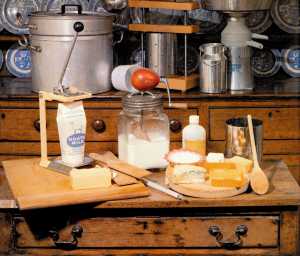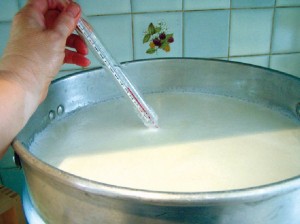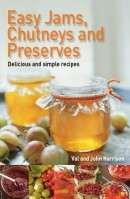Making cheese need not be difficult as long as attention is paid to the quality and handling of the milk, hygienic procedures are followed and the appropriate equipment is used. It is appropriate to look at what processes are involved and what equipment is needed.

Small scale cheese making in the kitchen was traditional in country areas where often a house cow was kept or a pair of nanny goats
How Milk Becomes Cheese
If milk is left it will ripen and eventually turn sour. This is because bacteria act on the milk sugar lactose, producing lactic acid. This, in turn, brings about a separation of the milk into solid curds and liquid whey.
It is the curds that eventually form cheese. The problem with producing cheese in this way is twofold:
- An extended period of natural souring encourages the growth of unsuitable, possibly harmful bacteria.
- The milk may have become too acidic for the particular cheese recipe.
Pasteurisation of Milk for Cheese Making
The safest way of producing cheese is to first pasteurise the milk by heating it to 66°C for half an hour, so that any unwelcome bacteria are removed.
Do not overheat when pasteurising or you may cause the casein to prematurely react, curdling the milk.
Adding the Cheese Starter Culture
Then, the milk is cooled and a culture of appropriate bacteria (a lacto-bacilli starter) is added so that the milk is ripened without needing an extended period to do so.
Adding & Effect of Rennet
Traditionally, the evening’s milking was set aside to ripen and then mixed with the morning’s milking, so that it provided a natural starter. Many people still use this method and there is nothing wrong with it as long as the quality of milk in its production and handling are second to none.
If there is any doubt about the quality of the milk, it should be pasteurised before use.
Next In Making Cheese at Home
Next we look at the Equipment for Cheesemaking >>
© Copyright Katie Thear 2006 Author of Cheesemaking and Dairying
Making Cheese Articles & Information
- Cheese Making Equipment for Making Cheese at Home
- Milk & Starter Cultures – Ingredients for Making Cheese
- Cheese Making – Ingredients for Making Cheese at Home – Rennet, Salt, Herbs etc
- Making Cheddar Cheese at Home
- How to Make Your Own Cottage / Curd Cheese at Home



